Comprehensive Analysis of Capital Market Financing in Bangladesh
VerifiedAdded on 2022/07/07
|26
|7801
|80
Report
AI Summary
This report provides a comprehensive overview of capital market financing, with a specific focus on the context of Bangladesh. It begins with an executive summary and introduction, defining the capital market and its significance. The report then delves into the capital market of Bangladesh, discussing its position in South Asia and the role of the Dhaka Stock Exchange (DSE) and Chittagong Stock Exchange (CSE). It covers the types of capital markets, including primary and secondary markets, and details their operations, particularly focusing on Initial Public Offerings (IPOs). The report also explores the instruments of the capital market, such as shares, debentures, and bonds, and includes a SWOT analysis of the stock market and discusses circuit breakers, company categories, and settlement cycles. It also addresses the problems of the capital market structure in Bangladesh and provides a math portion related to financial calculations. The report concludes with a summary of key findings and a list of references, offering a detailed analysis of capital market financing in the Bangladeshi context.
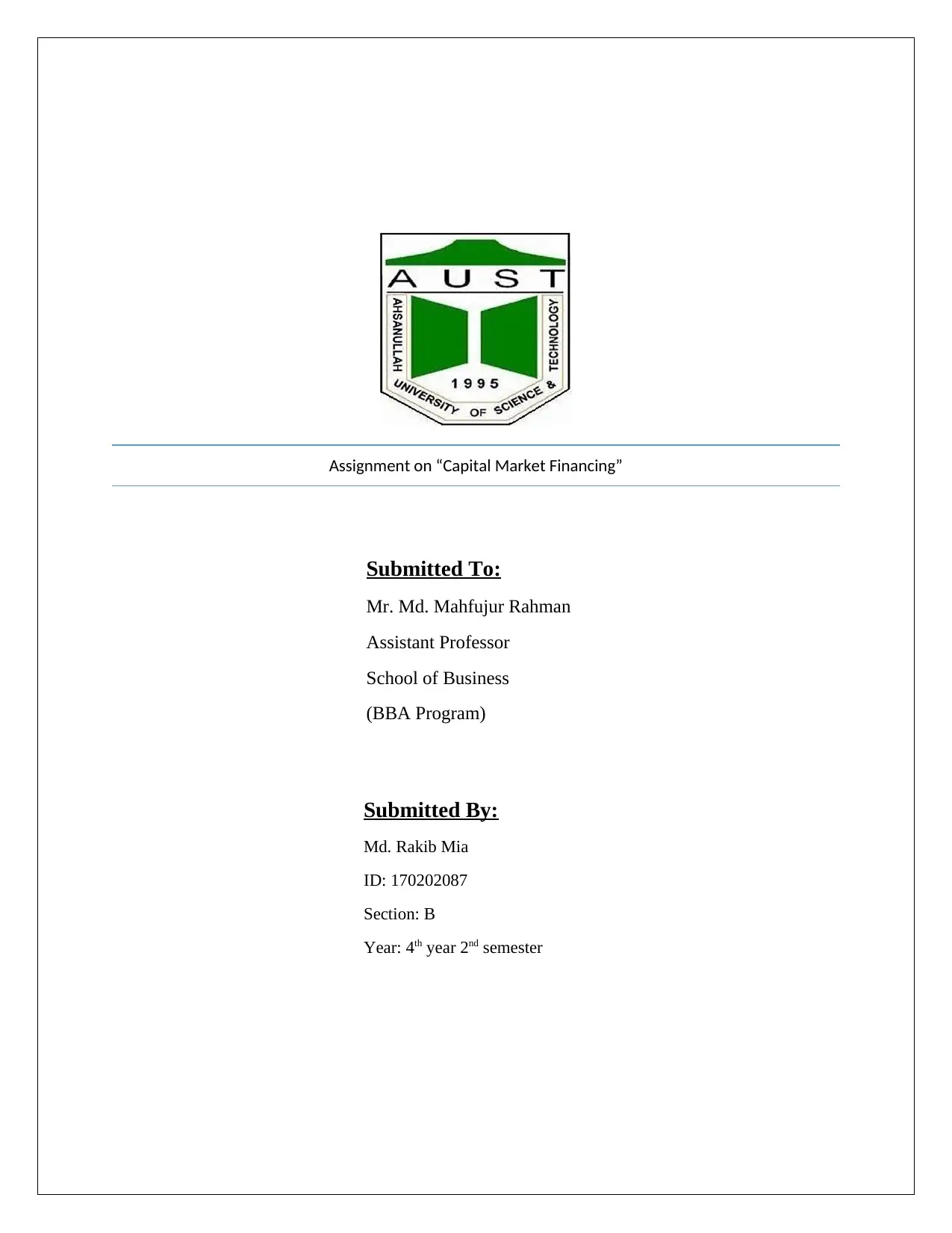
Assignment on “Capital Market Financing”
Submitted To:
Mr. Md. Mahfujur Rahman
Assistant Professor
School of Business
(BBA Program)
Submitted By:
Md. Rakib Mia
ID: 170202087
Section: B
Year: 4th year 2nd semester
Submitted To:
Mr. Md. Mahfujur Rahman
Assistant Professor
School of Business
(BBA Program)
Submitted By:
Md. Rakib Mia
ID: 170202087
Section: B
Year: 4th year 2nd semester
Paraphrase This Document
Need a fresh take? Get an instant paraphrase of this document with our AI Paraphraser
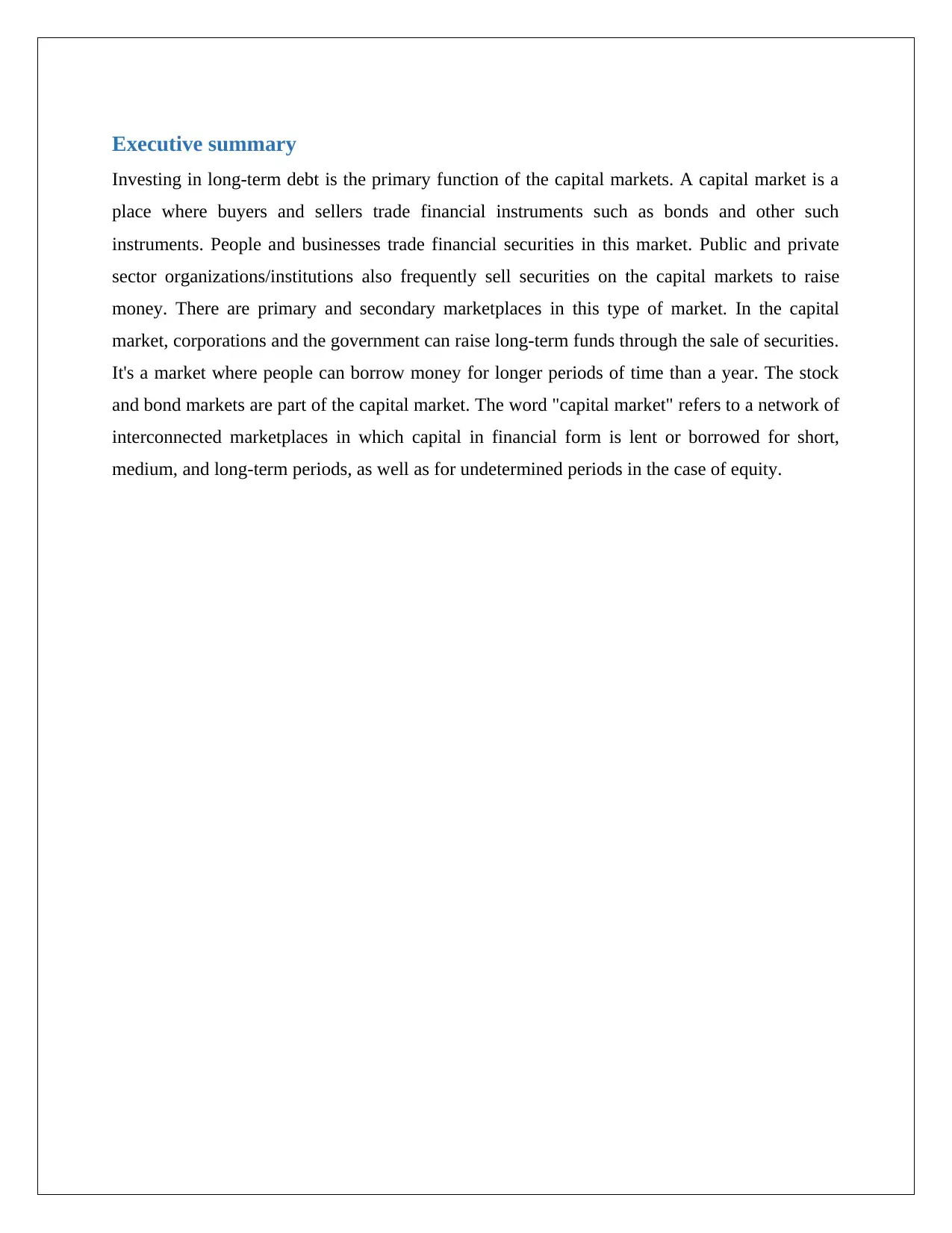
Executive summary
Investing in long-term debt is the primary function of the capital markets. A capital market is a
place where buyers and sellers trade financial instruments such as bonds and other such
instruments. People and businesses trade financial securities in this market. Public and private
sector organizations/institutions also frequently sell securities on the capital markets to raise
money. There are primary and secondary marketplaces in this type of market. In the capital
market, corporations and the government can raise long-term funds through the sale of securities.
It's a market where people can borrow money for longer periods of time than a year. The stock
and bond markets are part of the capital market. The word "capital market" refers to a network of
interconnected marketplaces in which capital in financial form is lent or borrowed for short,
medium, and long-term periods, as well as for undetermined periods in the case of equity.
Investing in long-term debt is the primary function of the capital markets. A capital market is a
place where buyers and sellers trade financial instruments such as bonds and other such
instruments. People and businesses trade financial securities in this market. Public and private
sector organizations/institutions also frequently sell securities on the capital markets to raise
money. There are primary and secondary marketplaces in this type of market. In the capital
market, corporations and the government can raise long-term funds through the sale of securities.
It's a market where people can borrow money for longer periods of time than a year. The stock
and bond markets are part of the capital market. The word "capital market" refers to a network of
interconnected marketplaces in which capital in financial form is lent or borrowed for short,
medium, and long-term periods, as well as for undetermined periods in the case of equity.
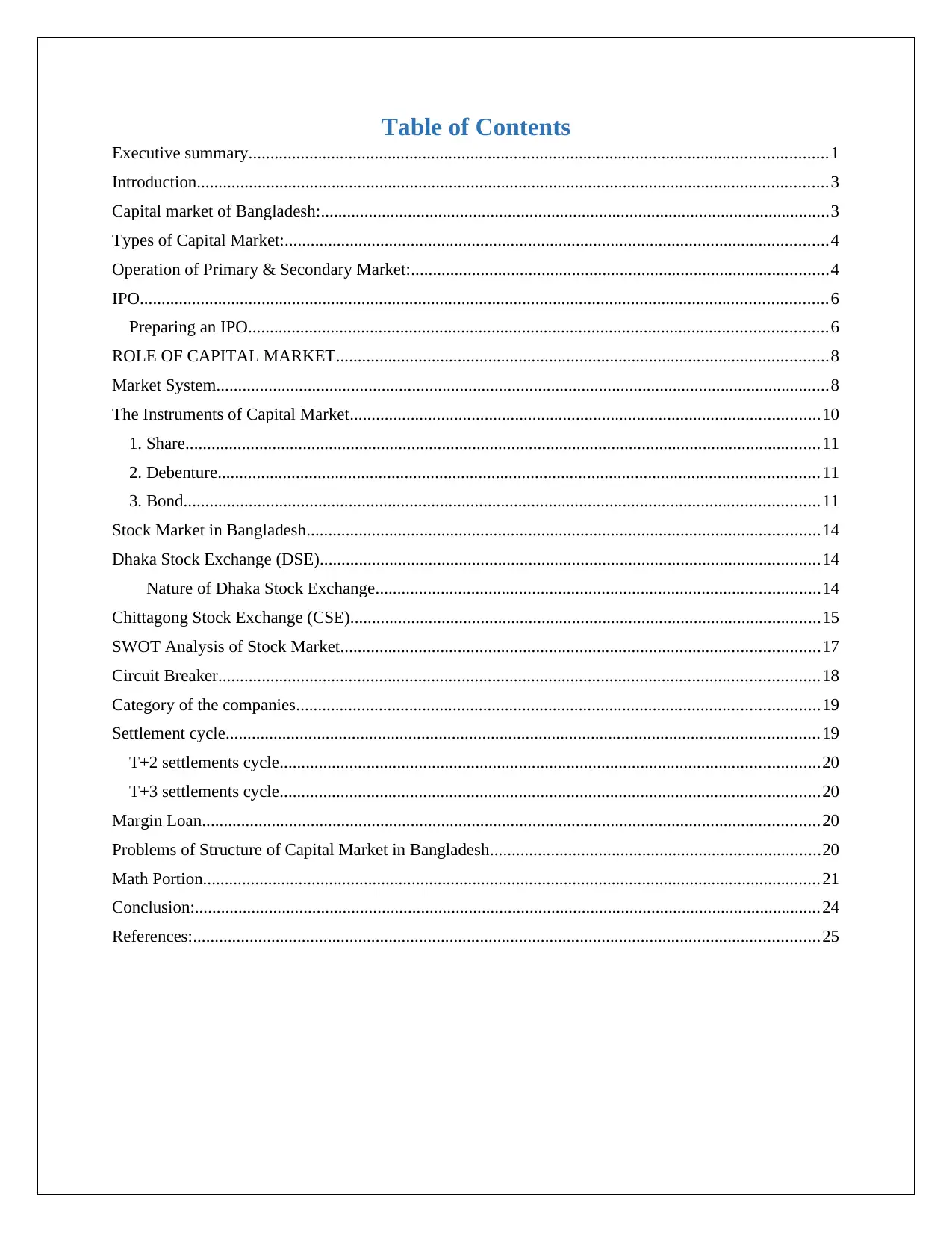
Table of Contents
Executive summary.....................................................................................................................................1
Introduction.................................................................................................................................................3
Capital market of Bangladesh:.....................................................................................................................3
Types of Capital Market:.............................................................................................................................4
Operation of Primary & Secondary Market:................................................................................................4
IPO..............................................................................................................................................................6
Preparing an IPO.....................................................................................................................................6
ROLE OF CAPITAL MARKET.................................................................................................................8
Market System.............................................................................................................................................8
The Instruments of Capital Market............................................................................................................10
1. Share..................................................................................................................................................11
2. Debenture..........................................................................................................................................11
3. Bond..................................................................................................................................................11
Stock Market in Bangladesh......................................................................................................................14
Dhaka Stock Exchange (DSE)...................................................................................................................14
Nature of Dhaka Stock Exchange......................................................................................................14
Chittagong Stock Exchange (CSE)............................................................................................................15
SWOT Analysis of Stock Market..............................................................................................................17
Circuit Breaker..........................................................................................................................................18
Category of the companies........................................................................................................................19
Settlement cycle........................................................................................................................................19
T+2 settlements cycle............................................................................................................................20
T+3 settlements cycle............................................................................................................................20
Margin Loan..............................................................................................................................................20
Problems of Structure of Capital Market in Bangladesh............................................................................20
Math Portion..............................................................................................................................................21
Conclusion:................................................................................................................................................24
References:................................................................................................................................................25
Executive summary.....................................................................................................................................1
Introduction.................................................................................................................................................3
Capital market of Bangladesh:.....................................................................................................................3
Types of Capital Market:.............................................................................................................................4
Operation of Primary & Secondary Market:................................................................................................4
IPO..............................................................................................................................................................6
Preparing an IPO.....................................................................................................................................6
ROLE OF CAPITAL MARKET.................................................................................................................8
Market System.............................................................................................................................................8
The Instruments of Capital Market............................................................................................................10
1. Share..................................................................................................................................................11
2. Debenture..........................................................................................................................................11
3. Bond..................................................................................................................................................11
Stock Market in Bangladesh......................................................................................................................14
Dhaka Stock Exchange (DSE)...................................................................................................................14
Nature of Dhaka Stock Exchange......................................................................................................14
Chittagong Stock Exchange (CSE)............................................................................................................15
SWOT Analysis of Stock Market..............................................................................................................17
Circuit Breaker..........................................................................................................................................18
Category of the companies........................................................................................................................19
Settlement cycle........................................................................................................................................19
T+2 settlements cycle............................................................................................................................20
T+3 settlements cycle............................................................................................................................20
Margin Loan..............................................................................................................................................20
Problems of Structure of Capital Market in Bangladesh............................................................................20
Math Portion..............................................................................................................................................21
Conclusion:................................................................................................................................................24
References:................................................................................................................................................25
⊘ This is a preview!⊘
Do you want full access?
Subscribe today to unlock all pages.

Trusted by 1+ million students worldwide

Introduction
It is possible to describe the capital market as the engine that drives capital raising and, in turn,
the speed of industrialization and privatization. To put it another way, the capital market refers to
the country's stock exchanges. A market for long-term investment funds exists here.
Bangladesh's capital market is the third-largest in South Asia, while being one of the continents
smallest. In addition to the Dhaka Stock Market (DSE) and Chittagong Stock Exchange (CSE),
which both operate fully computerized stock exchanges, the country also has an over-the-counter
exchange run by CSE. The Securities and Exchange Commission (SEC) is also a part of the
regulatory structure because it implements and oversees rules and regulations to operate and
develop the capital market. For the settlement of CSE and DSE transactions in dematerialized
securities, Bangladesh's Central Depository Bangladesh Limited (CDBL) serves as Bangladesh's
only Central Depository. Many people are involved in the financial markets. All the major
financial institutions, including commercial banks, savings and loan associations, credit unions
and mutual savings banks as well as merchant bankers, discount houses and venture capital
companies, are included in this group. They also include investment clubs, pension funds and
stock exchanges, as well as underwriters, portfolio-managers and insurance companies.
Capital market of Bangladesh:
As part of the global financial system, Bangladesh's capital market is considered a "emerging"
market. Objectives: To create in Bangladesh a capital that is well-balanced, secure, and resilient
As the third biggest in South Asia, Bangladesh has a relatively tiny capital market. Dhaka Stock
Exchange (DSE) and Chittagong Stock Exchange are the two fully automated stock exchanges in
Bangladesh (CSE). BSEC was founded in 1993 to supervise the activity of the exchanges, ensure
proper issuance of securities and compliance with regulations, and protect the interests of
securities investors after many years of operations.
It is possible to describe the capital market as the engine that drives capital raising and, in turn,
the speed of industrialization and privatization. To put it another way, the capital market refers to
the country's stock exchanges. A market for long-term investment funds exists here.
Bangladesh's capital market is the third-largest in South Asia, while being one of the continents
smallest. In addition to the Dhaka Stock Market (DSE) and Chittagong Stock Exchange (CSE),
which both operate fully computerized stock exchanges, the country also has an over-the-counter
exchange run by CSE. The Securities and Exchange Commission (SEC) is also a part of the
regulatory structure because it implements and oversees rules and regulations to operate and
develop the capital market. For the settlement of CSE and DSE transactions in dematerialized
securities, Bangladesh's Central Depository Bangladesh Limited (CDBL) serves as Bangladesh's
only Central Depository. Many people are involved in the financial markets. All the major
financial institutions, including commercial banks, savings and loan associations, credit unions
and mutual savings banks as well as merchant bankers, discount houses and venture capital
companies, are included in this group. They also include investment clubs, pension funds and
stock exchanges, as well as underwriters, portfolio-managers and insurance companies.
Capital market of Bangladesh:
As part of the global financial system, Bangladesh's capital market is considered a "emerging"
market. Objectives: To create in Bangladesh a capital that is well-balanced, secure, and resilient
As the third biggest in South Asia, Bangladesh has a relatively tiny capital market. Dhaka Stock
Exchange (DSE) and Chittagong Stock Exchange are the two fully automated stock exchanges in
Bangladesh (CSE). BSEC was founded in 1993 to supervise the activity of the exchanges, ensure
proper issuance of securities and compliance with regulations, and protect the interests of
securities investors after many years of operations.
Paraphrase This Document
Need a fresh take? Get an instant paraphrase of this document with our AI Paraphraser
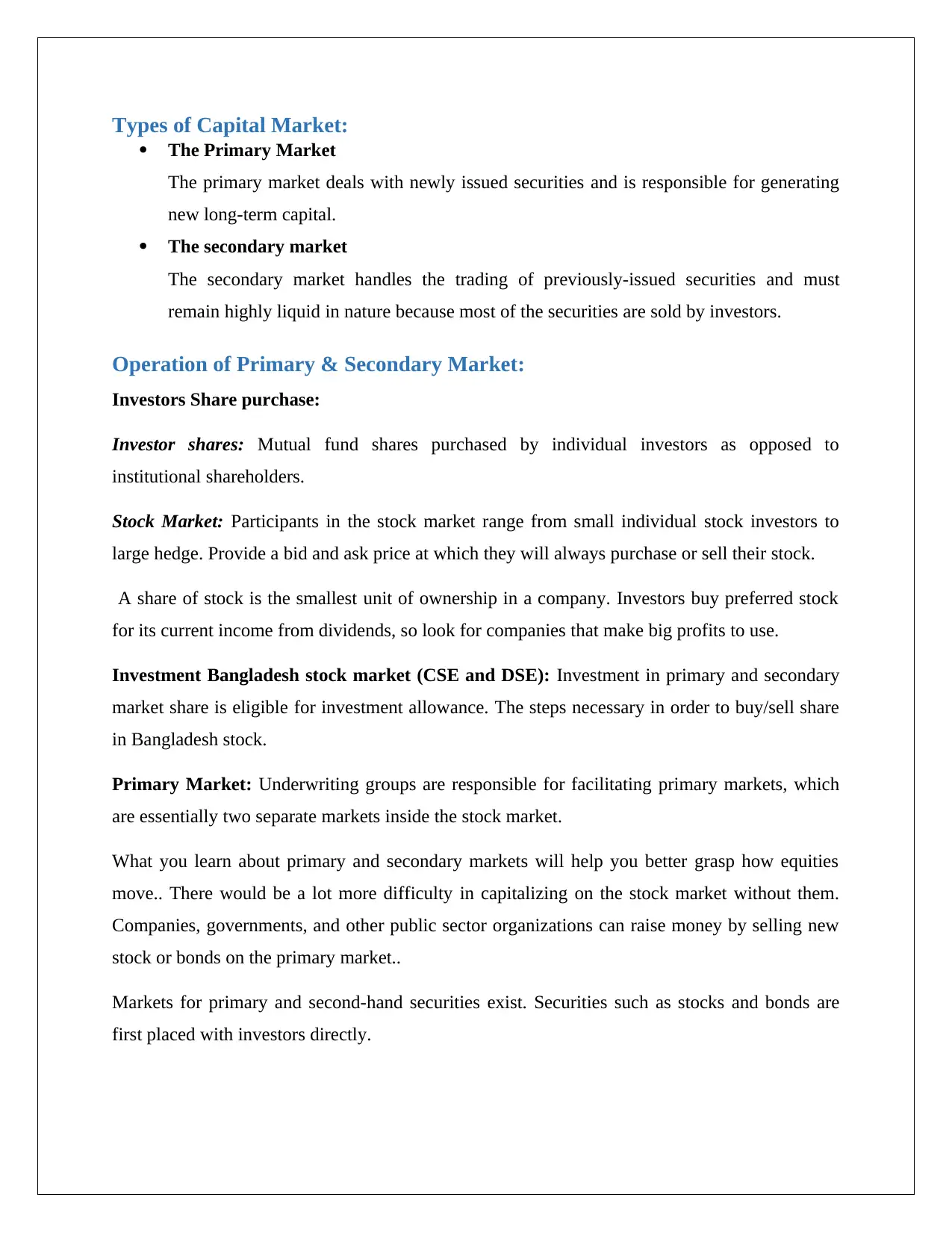
Types of Capital Market:
The Primary Market
The primary market deals with newly issued securities and is responsible for generating
new long-term capital.
The secondary market
The secondary market handles the trading of previously-issued securities and must
remain highly liquid in nature because most of the securities are sold by investors.
Operation of Primary & Secondary Market:
Investors Share purchase:
Investor shares: Mutual fund shares purchased by individual investors as opposed to
institutional shareholders.
Stock Market: Participants in the stock market range from small individual stock investors to
large hedge. Provide a bid and ask price at which they will always purchase or sell their stock.
A share of stock is the smallest unit of ownership in a company. Investors buy preferred stock
for its current income from dividends, so look for companies that make big profits to use.
Investment Bangladesh stock market (CSE and DSE): Investment in primary and secondary
market share is eligible for investment allowance. The steps necessary in order to buy/sell share
in Bangladesh stock.
Primary Market: Underwriting groups are responsible for facilitating primary markets, which
are essentially two separate markets inside the stock market.
What you learn about primary and secondary markets will help you better grasp how equities
move.. There would be a lot more difficulty in capitalizing on the stock market without them.
Companies, governments, and other public sector organizations can raise money by selling new
stock or bonds on the primary market..
Markets for primary and second-hand securities exist. Securities such as stocks and bonds are
first placed with investors directly.
The Primary Market
The primary market deals with newly issued securities and is responsible for generating
new long-term capital.
The secondary market
The secondary market handles the trading of previously-issued securities and must
remain highly liquid in nature because most of the securities are sold by investors.
Operation of Primary & Secondary Market:
Investors Share purchase:
Investor shares: Mutual fund shares purchased by individual investors as opposed to
institutional shareholders.
Stock Market: Participants in the stock market range from small individual stock investors to
large hedge. Provide a bid and ask price at which they will always purchase or sell their stock.
A share of stock is the smallest unit of ownership in a company. Investors buy preferred stock
for its current income from dividends, so look for companies that make big profits to use.
Investment Bangladesh stock market (CSE and DSE): Investment in primary and secondary
market share is eligible for investment allowance. The steps necessary in order to buy/sell share
in Bangladesh stock.
Primary Market: Underwriting groups are responsible for facilitating primary markets, which
are essentially two separate markets inside the stock market.
What you learn about primary and secondary markets will help you better grasp how equities
move.. There would be a lot more difficulty in capitalizing on the stock market without them.
Companies, governments, and other public sector organizations can raise money by selling new
stock or bonds on the primary market..
Markets for primary and second-hand securities exist. Securities such as stocks and bonds are
first placed with investors directly.
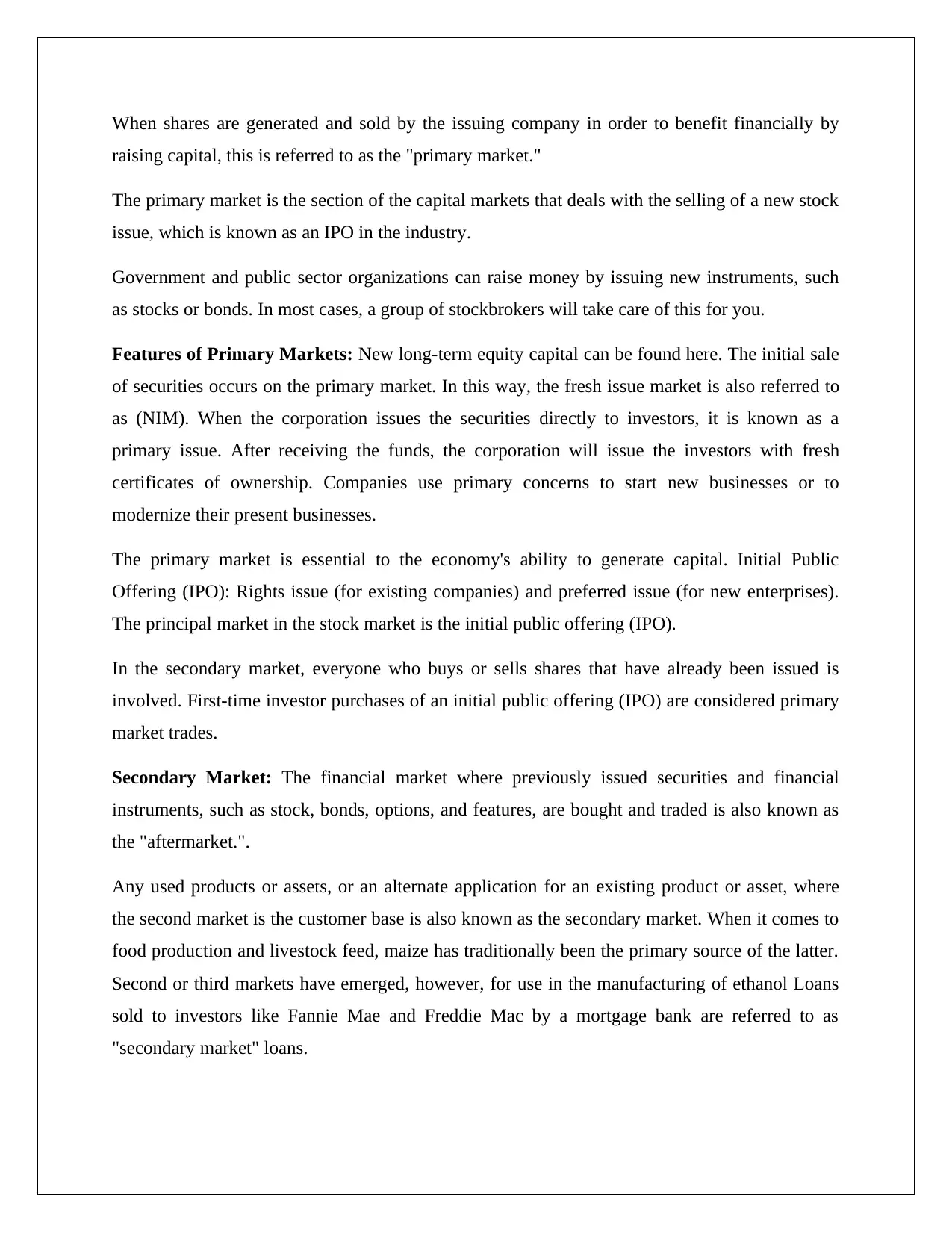
When shares are generated and sold by the issuing company in order to benefit financially by
raising capital, this is referred to as the "primary market."
The primary market is the section of the capital markets that deals with the selling of a new stock
issue, which is known as an IPO in the industry.
Government and public sector organizations can raise money by issuing new instruments, such
as stocks or bonds. In most cases, a group of stockbrokers will take care of this for you.
Features of Primary Markets: New long-term equity capital can be found here. The initial sale
of securities occurs on the primary market. In this way, the fresh issue market is also referred to
as (NIM). When the corporation issues the securities directly to investors, it is known as a
primary issue. After receiving the funds, the corporation will issue the investors with fresh
certificates of ownership. Companies use primary concerns to start new businesses or to
modernize their present businesses.
The primary market is essential to the economy's ability to generate capital. Initial Public
Offering (IPO): Rights issue (for existing companies) and preferred issue (for new enterprises).
The principal market in the stock market is the initial public offering (IPO).
In the secondary market, everyone who buys or sells shares that have already been issued is
involved. First-time investor purchases of an initial public offering (IPO) are considered primary
market trades.
Secondary Market: The financial market where previously issued securities and financial
instruments, such as stock, bonds, options, and features, are bought and traded is also known as
the "aftermarket.".
Any used products or assets, or an alternate application for an existing product or asset, where
the second market is the customer base is also known as the secondary market. When it comes to
food production and livestock feed, maize has traditionally been the primary source of the latter.
Second or third markets have emerged, however, for use in the manufacturing of ethanol Loans
sold to investors like Fannie Mae and Freddie Mac by a mortgage bank are referred to as
"secondary market" loans.
raising capital, this is referred to as the "primary market."
The primary market is the section of the capital markets that deals with the selling of a new stock
issue, which is known as an IPO in the industry.
Government and public sector organizations can raise money by issuing new instruments, such
as stocks or bonds. In most cases, a group of stockbrokers will take care of this for you.
Features of Primary Markets: New long-term equity capital can be found here. The initial sale
of securities occurs on the primary market. In this way, the fresh issue market is also referred to
as (NIM). When the corporation issues the securities directly to investors, it is known as a
primary issue. After receiving the funds, the corporation will issue the investors with fresh
certificates of ownership. Companies use primary concerns to start new businesses or to
modernize their present businesses.
The primary market is essential to the economy's ability to generate capital. Initial Public
Offering (IPO): Rights issue (for existing companies) and preferred issue (for new enterprises).
The principal market in the stock market is the initial public offering (IPO).
In the secondary market, everyone who buys or sells shares that have already been issued is
involved. First-time investor purchases of an initial public offering (IPO) are considered primary
market trades.
Secondary Market: The financial market where previously issued securities and financial
instruments, such as stock, bonds, options, and features, are bought and traded is also known as
the "aftermarket.".
Any used products or assets, or an alternate application for an existing product or asset, where
the second market is the customer base is also known as the secondary market. When it comes to
food production and livestock feed, maize has traditionally been the primary source of the latter.
Second or third markets have emerged, however, for use in the manufacturing of ethanol Loans
sold to investors like Fannie Mae and Freddie Mac by a mortgage bank are referred to as
"secondary market" loans.
⊘ This is a preview!⊘
Do you want full access?
Subscribe today to unlock all pages.

Trusted by 1+ million students worldwide
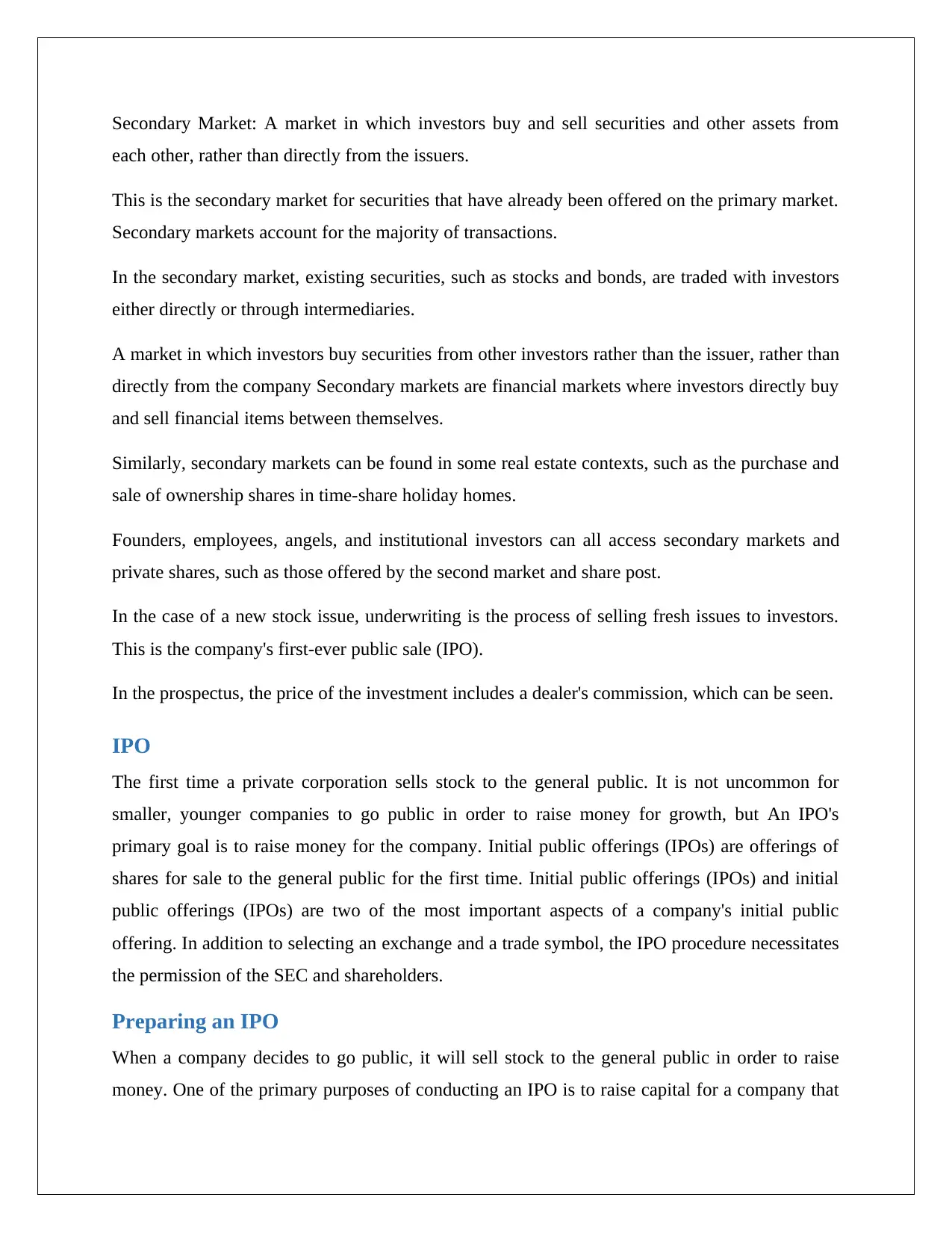
Secondary Market: A market in which investors buy and sell securities and other assets from
each other, rather than directly from the issuers.
This is the secondary market for securities that have already been offered on the primary market.
Secondary markets account for the majority of transactions.
In the secondary market, existing securities, such as stocks and bonds, are traded with investors
either directly or through intermediaries.
A market in which investors buy securities from other investors rather than the issuer, rather than
directly from the company Secondary markets are financial markets where investors directly buy
and sell financial items between themselves.
Similarly, secondary markets can be found in some real estate contexts, such as the purchase and
sale of ownership shares in time-share holiday homes.
Founders, employees, angels, and institutional investors can all access secondary markets and
private shares, such as those offered by the second market and share post.
In the case of a new stock issue, underwriting is the process of selling fresh issues to investors.
This is the company's first-ever public sale (IPO).
In the prospectus, the price of the investment includes a dealer's commission, which can be seen.
IPO
The first time a private corporation sells stock to the general public. It is not uncommon for
smaller, younger companies to go public in order to raise money for growth, but An IPO's
primary goal is to raise money for the company. Initial public offerings (IPOs) are offerings of
shares for sale to the general public for the first time. Initial public offerings (IPOs) and initial
public offerings (IPOs) are two of the most important aspects of a company's initial public
offering. In addition to selecting an exchange and a trade symbol, the IPO procedure necessitates
the permission of the SEC and shareholders.
Preparing an IPO
When a company decides to go public, it will sell stock to the general public in order to raise
money. One of the primary purposes of conducting an IPO is to raise capital for a company that
each other, rather than directly from the issuers.
This is the secondary market for securities that have already been offered on the primary market.
Secondary markets account for the majority of transactions.
In the secondary market, existing securities, such as stocks and bonds, are traded with investors
either directly or through intermediaries.
A market in which investors buy securities from other investors rather than the issuer, rather than
directly from the company Secondary markets are financial markets where investors directly buy
and sell financial items between themselves.
Similarly, secondary markets can be found in some real estate contexts, such as the purchase and
sale of ownership shares in time-share holiday homes.
Founders, employees, angels, and institutional investors can all access secondary markets and
private shares, such as those offered by the second market and share post.
In the case of a new stock issue, underwriting is the process of selling fresh issues to investors.
This is the company's first-ever public sale (IPO).
In the prospectus, the price of the investment includes a dealer's commission, which can be seen.
IPO
The first time a private corporation sells stock to the general public. It is not uncommon for
smaller, younger companies to go public in order to raise money for growth, but An IPO's
primary goal is to raise money for the company. Initial public offerings (IPOs) are offerings of
shares for sale to the general public for the first time. Initial public offerings (IPOs) and initial
public offerings (IPOs) are two of the most important aspects of a company's initial public
offering. In addition to selecting an exchange and a trade symbol, the IPO procedure necessitates
the permission of the SEC and shareholders.
Preparing an IPO
When a company decides to go public, it will sell stock to the general public in order to raise
money. One of the primary purposes of conducting an IPO is to raise capital for a company that
Paraphrase This Document
Need a fresh take? Get an instant paraphrase of this document with our AI Paraphraser

has been privately held. It is frequently the primary means by which a new business can raise the
capital it requires to be successful in the marketplace.
To preparing an IPO there are 5 steps available & they are given below:
1. Determine if company is eligible to go public: Businesses that are eligible for an initial
public offering (IPO) often have a track record of profitability and a sizable quantity of cash on
hand. If you're not sure if your firm is the type that the general public would be interested in
investing in, talk to an investment banker or outside consultant about setting up a meeting.
2. Contract with an investment banker: Investment bankers can assist you decide how much
money to raise, how much stock to sell, and how much of the firm to put up for sale in the first
public offering. At this point, the investment banker is acting as an underwriter, agreeing to buy
all shares the firm wishes to offer.
3. Draft a prospect and file it with the Securities and Exchange Commission (SEC):
It is referred to by the SEC as "S-1." Its primary function is to provide information about the
company. Even if the number of shares and the price per share in the IPO C have not been
decided, an estimate of what they will be is contained in the initial prospectus, the first document
filed by the companies. Early in the IPO process, the initial prospectus is submitted. A few days
before the initial public offering, the company filed its final prospectus. In this offering, the
number of shares and their value are both predetermined.
4. Present the opportunity to potential shareholders: People and groups will be encouraged to
purchase IPO shares through presentations and offers made by the Banker and the corporation's
top officials before the actual IPO. The investment banker evaluates possible investors based on
the sort of firm that desires to go public and the interest that the potential investor may have in
the corporation. Non-binding pledges to buy stock are created through this procedure and are
referred to as "subscriptions." As described in the first stage, it is Longley used as a tool to
determine whether or not the public is interested in investing in the company, as well as the price
of a share.
5. Sell the shares to the investment banker: The investment banker will buy the shares on the
day of the IPO and sell them to investors at the same time. To calculate the banker's price, the
capital it requires to be successful in the marketplace.
To preparing an IPO there are 5 steps available & they are given below:
1. Determine if company is eligible to go public: Businesses that are eligible for an initial
public offering (IPO) often have a track record of profitability and a sizable quantity of cash on
hand. If you're not sure if your firm is the type that the general public would be interested in
investing in, talk to an investment banker or outside consultant about setting up a meeting.
2. Contract with an investment banker: Investment bankers can assist you decide how much
money to raise, how much stock to sell, and how much of the firm to put up for sale in the first
public offering. At this point, the investment banker is acting as an underwriter, agreeing to buy
all shares the firm wishes to offer.
3. Draft a prospect and file it with the Securities and Exchange Commission (SEC):
It is referred to by the SEC as "S-1." Its primary function is to provide information about the
company. Even if the number of shares and the price per share in the IPO C have not been
decided, an estimate of what they will be is contained in the initial prospectus, the first document
filed by the companies. Early in the IPO process, the initial prospectus is submitted. A few days
before the initial public offering, the company filed its final prospectus. In this offering, the
number of shares and their value are both predetermined.
4. Present the opportunity to potential shareholders: People and groups will be encouraged to
purchase IPO shares through presentations and offers made by the Banker and the corporation's
top officials before the actual IPO. The investment banker evaluates possible investors based on
the sort of firm that desires to go public and the interest that the potential investor may have in
the corporation. Non-binding pledges to buy stock are created through this procedure and are
referred to as "subscriptions." As described in the first stage, it is Longley used as a tool to
determine whether or not the public is interested in investing in the company, as well as the price
of a share.
5. Sell the shares to the investment banker: The investment banker will buy the shares on the
day of the IPO and sell them to investors at the same time. To calculate the banker's price, the
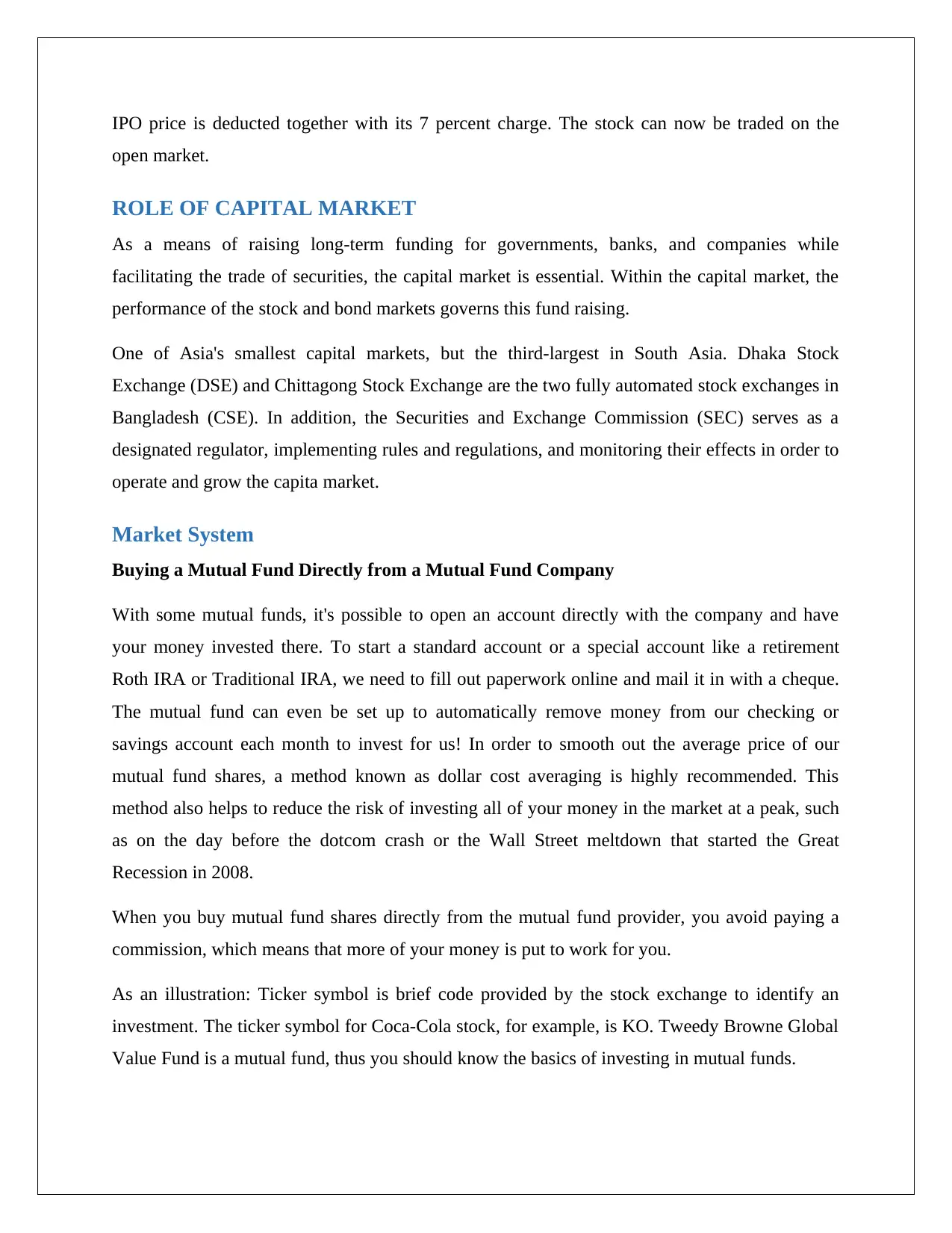
IPO price is deducted together with its 7 percent charge. The stock can now be traded on the
open market.
ROLE OF CAPITAL MARKET
As a means of raising long-term funding for governments, banks, and companies while
facilitating the trade of securities, the capital market is essential. Within the capital market, the
performance of the stock and bond markets governs this fund raising.
One of Asia's smallest capital markets, but the third-largest in South Asia. Dhaka Stock
Exchange (DSE) and Chittagong Stock Exchange are the two fully automated stock exchanges in
Bangladesh (CSE). In addition, the Securities and Exchange Commission (SEC) serves as a
designated regulator, implementing rules and regulations, and monitoring their effects in order to
operate and grow the capita market.
Market System
Buying a Mutual Fund Directly from a Mutual Fund Company
With some mutual funds, it's possible to open an account directly with the company and have
your money invested there. To start a standard account or a special account like a retirement
Roth IRA or Traditional IRA, we need to fill out paperwork online and mail it in with a cheque.
The mutual fund can even be set up to automatically remove money from our checking or
savings account each month to invest for us! In order to smooth out the average price of our
mutual fund shares, a method known as dollar cost averaging is highly recommended. This
method also helps to reduce the risk of investing all of your money in the market at a peak, such
as on the day before the dotcom crash or the Wall Street meltdown that started the Great
Recession in 2008.
When you buy mutual fund shares directly from the mutual fund provider, you avoid paying a
commission, which means that more of your money is put to work for you.
As an illustration: Ticker symbol is brief code provided by the stock exchange to identify an
investment. The ticker symbol for Coca-Cola stock, for example, is KO. Tweedy Browne Global
Value Fund is a mutual fund, thus you should know the basics of investing in mutual funds.
open market.
ROLE OF CAPITAL MARKET
As a means of raising long-term funding for governments, banks, and companies while
facilitating the trade of securities, the capital market is essential. Within the capital market, the
performance of the stock and bond markets governs this fund raising.
One of Asia's smallest capital markets, but the third-largest in South Asia. Dhaka Stock
Exchange (DSE) and Chittagong Stock Exchange are the two fully automated stock exchanges in
Bangladesh (CSE). In addition, the Securities and Exchange Commission (SEC) serves as a
designated regulator, implementing rules and regulations, and monitoring their effects in order to
operate and grow the capita market.
Market System
Buying a Mutual Fund Directly from a Mutual Fund Company
With some mutual funds, it's possible to open an account directly with the company and have
your money invested there. To start a standard account or a special account like a retirement
Roth IRA or Traditional IRA, we need to fill out paperwork online and mail it in with a cheque.
The mutual fund can even be set up to automatically remove money from our checking or
savings account each month to invest for us! In order to smooth out the average price of our
mutual fund shares, a method known as dollar cost averaging is highly recommended. This
method also helps to reduce the risk of investing all of your money in the market at a peak, such
as on the day before the dotcom crash or the Wall Street meltdown that started the Great
Recession in 2008.
When you buy mutual fund shares directly from the mutual fund provider, you avoid paying a
commission, which means that more of your money is put to work for you.
As an illustration: Ticker symbol is brief code provided by the stock exchange to identify an
investment. The ticker symbol for Coca-Cola stock, for example, is KO. Tweedy Browne Global
Value Fund is a mutual fund, thus you should know the basics of investing in mutual funds.
⊘ This is a preview!⊘
Do you want full access?
Subscribe today to unlock all pages.

Trusted by 1+ million students worldwide
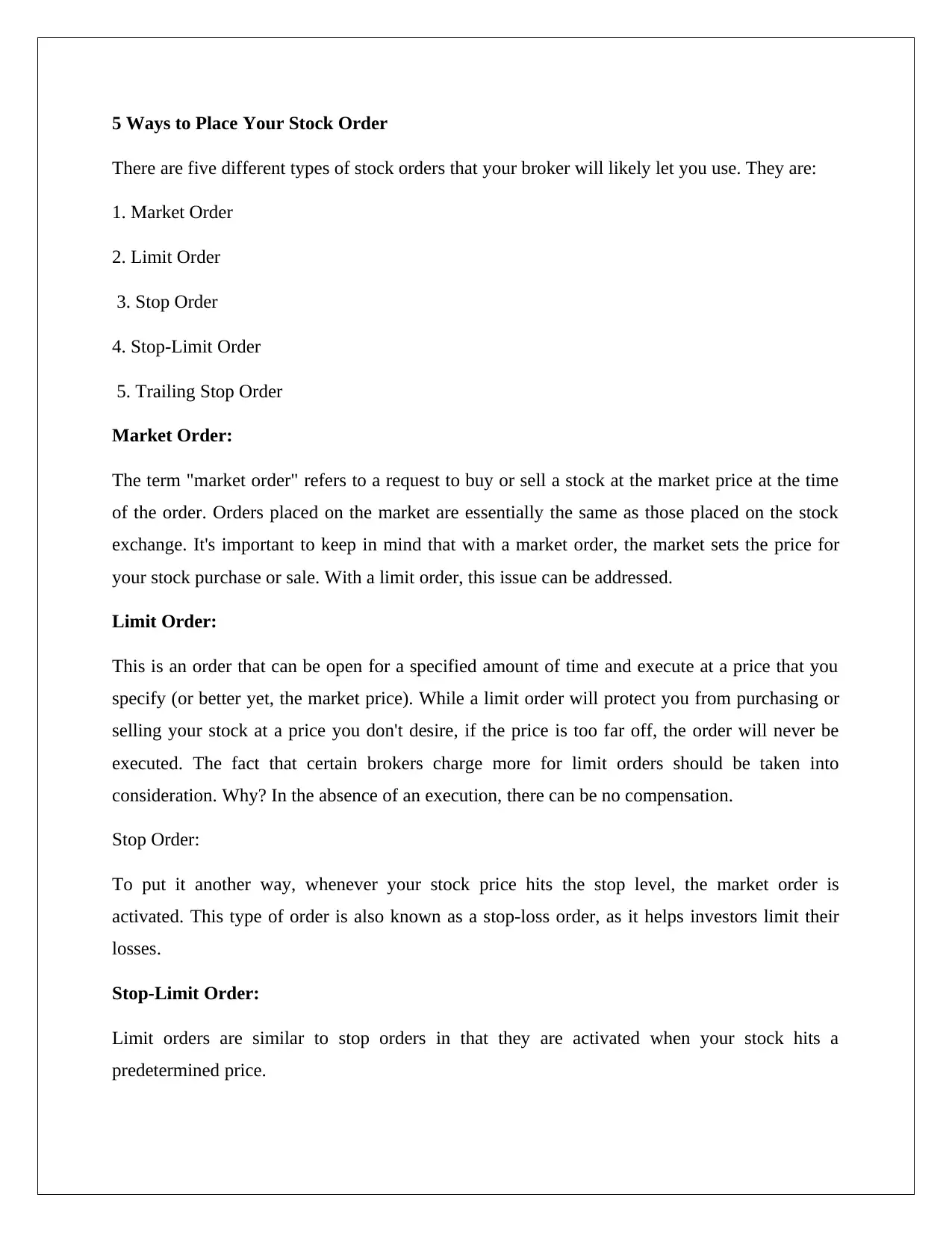
5 Ways to Place Your Stock Order
There are five different types of stock orders that your broker will likely let you use. They are:
1. Market Order
2. Limit Order
3. Stop Order
4. Stop-Limit Order
5. Trailing Stop Order
Market Order:
The term "market order" refers to a request to buy or sell a stock at the market price at the time
of the order. Orders placed on the market are essentially the same as those placed on the stock
exchange. It's important to keep in mind that with a market order, the market sets the price for
your stock purchase or sale. With a limit order, this issue can be addressed.
Limit Order:
This is an order that can be open for a specified amount of time and execute at a price that you
specify (or better yet, the market price). While a limit order will protect you from purchasing or
selling your stock at a price you don't desire, if the price is too far off, the order will never be
executed. The fact that certain brokers charge more for limit orders should be taken into
consideration. Why? In the absence of an execution, there can be no compensation.
Stop Order:
To put it another way, whenever your stock price hits the stop level, the market order is
activated. This type of order is also known as a stop-loss order, as it helps investors limit their
losses.
Stop-Limit Order:
Limit orders are similar to stop orders in that they are activated when your stock hits a
predetermined price.
There are five different types of stock orders that your broker will likely let you use. They are:
1. Market Order
2. Limit Order
3. Stop Order
4. Stop-Limit Order
5. Trailing Stop Order
Market Order:
The term "market order" refers to a request to buy or sell a stock at the market price at the time
of the order. Orders placed on the market are essentially the same as those placed on the stock
exchange. It's important to keep in mind that with a market order, the market sets the price for
your stock purchase or sale. With a limit order, this issue can be addressed.
Limit Order:
This is an order that can be open for a specified amount of time and execute at a price that you
specify (or better yet, the market price). While a limit order will protect you from purchasing or
selling your stock at a price you don't desire, if the price is too far off, the order will never be
executed. The fact that certain brokers charge more for limit orders should be taken into
consideration. Why? In the absence of an execution, there can be no compensation.
Stop Order:
To put it another way, whenever your stock price hits the stop level, the market order is
activated. This type of order is also known as a stop-loss order, as it helps investors limit their
losses.
Stop-Limit Order:
Limit orders are similar to stop orders in that they are activated when your stock hits a
predetermined price.
Paraphrase This Document
Need a fresh take? Get an instant paraphrase of this document with our AI Paraphraser
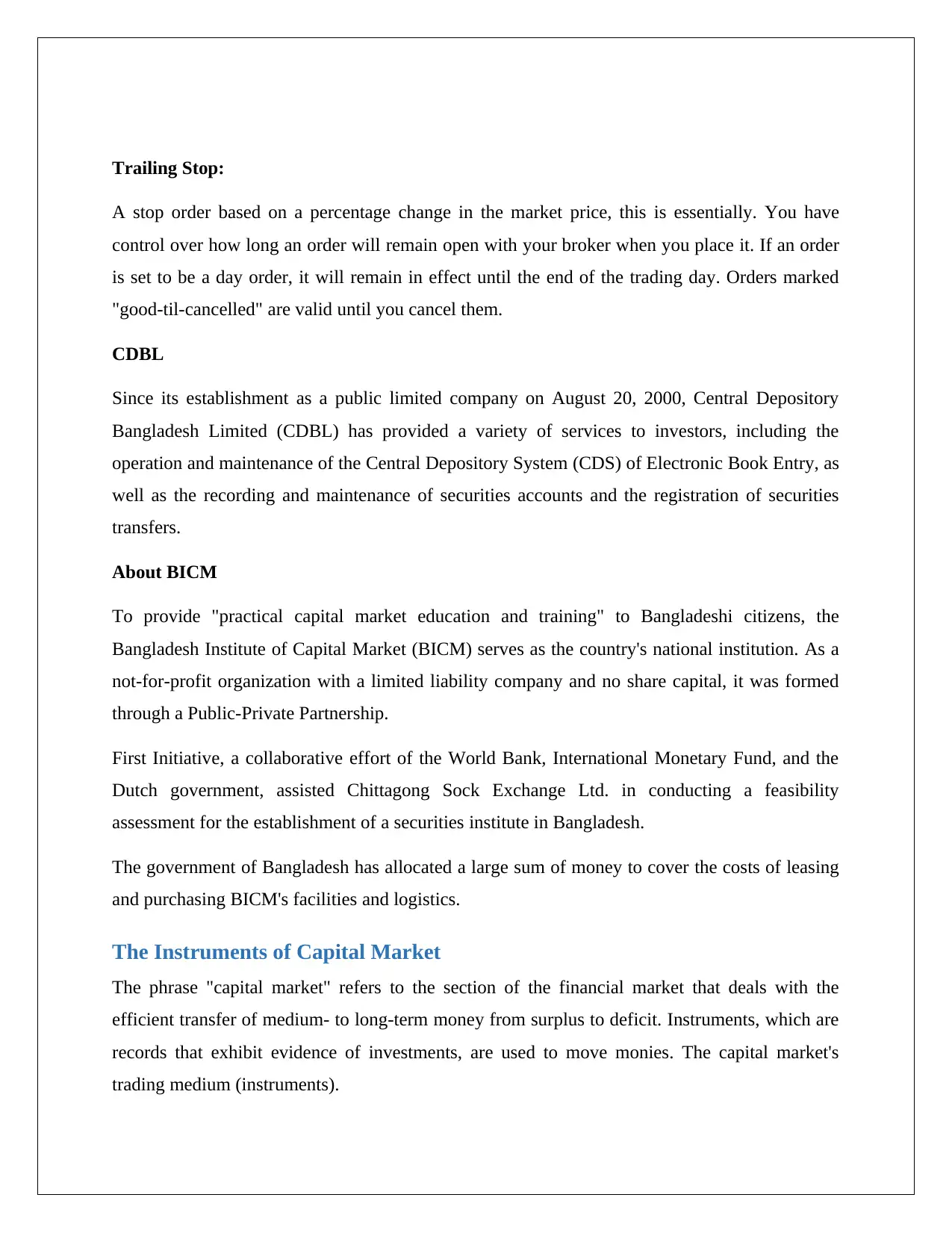
Trailing Stop:
A stop order based on a percentage change in the market price, this is essentially. You have
control over how long an order will remain open with your broker when you place it. If an order
is set to be a day order, it will remain in effect until the end of the trading day. Orders marked
"good-til-cancelled" are valid until you cancel them.
CDBL
Since its establishment as a public limited company on August 20, 2000, Central Depository
Bangladesh Limited (CDBL) has provided a variety of services to investors, including the
operation and maintenance of the Central Depository System (CDS) of Electronic Book Entry, as
well as the recording and maintenance of securities accounts and the registration of securities
transfers.
About BICM
To provide "practical capital market education and training" to Bangladeshi citizens, the
Bangladesh Institute of Capital Market (BICM) serves as the country's national institution. As a
not-for-profit organization with a limited liability company and no share capital, it was formed
through a Public-Private Partnership.
First Initiative, a collaborative effort of the World Bank, International Monetary Fund, and the
Dutch government, assisted Chittagong Sock Exchange Ltd. in conducting a feasibility
assessment for the establishment of a securities institute in Bangladesh.
The government of Bangladesh has allocated a large sum of money to cover the costs of leasing
and purchasing BICM's facilities and logistics.
The Instruments of Capital Market
The phrase "capital market" refers to the section of the financial market that deals with the
efficient transfer of medium- to long-term money from surplus to deficit. Instruments, which are
records that exhibit evidence of investments, are used to move monies. The capital market's
trading medium (instruments).
A stop order based on a percentage change in the market price, this is essentially. You have
control over how long an order will remain open with your broker when you place it. If an order
is set to be a day order, it will remain in effect until the end of the trading day. Orders marked
"good-til-cancelled" are valid until you cancel them.
CDBL
Since its establishment as a public limited company on August 20, 2000, Central Depository
Bangladesh Limited (CDBL) has provided a variety of services to investors, including the
operation and maintenance of the Central Depository System (CDS) of Electronic Book Entry, as
well as the recording and maintenance of securities accounts and the registration of securities
transfers.
About BICM
To provide "practical capital market education and training" to Bangladeshi citizens, the
Bangladesh Institute of Capital Market (BICM) serves as the country's national institution. As a
not-for-profit organization with a limited liability company and no share capital, it was formed
through a Public-Private Partnership.
First Initiative, a collaborative effort of the World Bank, International Monetary Fund, and the
Dutch government, assisted Chittagong Sock Exchange Ltd. in conducting a feasibility
assessment for the establishment of a securities institute in Bangladesh.
The government of Bangladesh has allocated a large sum of money to cover the costs of leasing
and purchasing BICM's facilities and logistics.
The Instruments of Capital Market
The phrase "capital market" refers to the section of the financial market that deals with the
efficient transfer of medium- to long-term money from surplus to deficit. Instruments, which are
records that exhibit evidence of investments, are used to move monies. The capital market's
trading medium (instruments).

Three types of capital market instruments are available to investors.
1. Share
2. Debenture
3. Bond
1. Share: There are many different types of financial instruments represented by the share,
including stocks, REITs, mutual funds, and limited partnerships. A shareholder, usually referred
to as a stockholder, is a person who holds stock in a business or organization and receives
dividends from that ownership. A stockbroker frequently serves as a go-between when it comes
to buying and selling shares.
Types of Share:
a) Preference Share: As a hybrid instrument, a Preference Share is a stock that can have any
combination of attributes that common stock does not, such as the properties of both an equity
and debt instrument.
b) Equity Share: Individuals and businesses acquire and hold stock on a stock market in order
to profit from dividends and capital gains when the stock's value improves, referred to as an
equity investment.
Valuation: Different markets use different principles to evaluate a stock. Whether or not a share
can be sold at any particular time depends on the market's liquidity. It is generally accepted that
an actual sale transaction between a buyer and a seller is the best predictor of the 'True value of
shares' at any given time.
Dividend: To put it simply, dividends are a portion of the company's overall profits that are
distributed to its shareholders. These are well-documented examples of capital gains reinvested.
2. Debenture: To generate or recognize a debt, the debenture is either a written document or an
electronic signature. A debenture can be classified into two sorts. • Convertible Debenture • Non-
Convertible
1. Share
2. Debenture
3. Bond
1. Share: There are many different types of financial instruments represented by the share,
including stocks, REITs, mutual funds, and limited partnerships. A shareholder, usually referred
to as a stockholder, is a person who holds stock in a business or organization and receives
dividends from that ownership. A stockbroker frequently serves as a go-between when it comes
to buying and selling shares.
Types of Share:
a) Preference Share: As a hybrid instrument, a Preference Share is a stock that can have any
combination of attributes that common stock does not, such as the properties of both an equity
and debt instrument.
b) Equity Share: Individuals and businesses acquire and hold stock on a stock market in order
to profit from dividends and capital gains when the stock's value improves, referred to as an
equity investment.
Valuation: Different markets use different principles to evaluate a stock. Whether or not a share
can be sold at any particular time depends on the market's liquidity. It is generally accepted that
an actual sale transaction between a buyer and a seller is the best predictor of the 'True value of
shares' at any given time.
Dividend: To put it simply, dividends are a portion of the company's overall profits that are
distributed to its shareholders. These are well-documented examples of capital gains reinvested.
2. Debenture: To generate or recognize a debt, the debenture is either a written document or an
electronic signature. A debenture can be classified into two sorts. • Convertible Debenture • Non-
Convertible
⊘ This is a preview!⊘
Do you want full access?
Subscribe today to unlock all pages.

Trusted by 1+ million students worldwide
1 out of 26
Your All-in-One AI-Powered Toolkit for Academic Success.
+13062052269
info@desklib.com
Available 24*7 on WhatsApp / Email
![[object Object]](/_next/static/media/star-bottom.7253800d.svg)
Unlock your academic potential
Copyright © 2020–2025 A2Z Services. All Rights Reserved. Developed and managed by ZUCOL.
